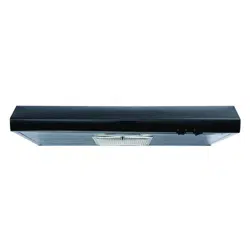Documents: Go to download!
- Owner's manual - (English)
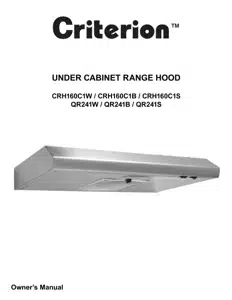
User Manual Range Hood
Installation
REMOVING THE ELECTRICAL KNOCKOUT HOLE
- Choose the appropriate electrical knock-out hole to remove for your installation type. Use the top hole (1) if your electrical supply is in the cabinet and the back hole (2) if your electrical supply is on the wall below the cabinet (refer to Fig. 10).

- Use a hammer and a flathead screwdriver to gently punch out the electrical knock-out hole.
INSTALLING THE DAMPER (SKIP THIS STEP IF YOU ARE USING INTERIOR VENTING)
- The damper is located inside the range hood . To access the damper, remove the bottom panel (D) if you had not already done so.
- Choose to install the damper (C) either in the top position (3) for top venting or in the back position (5) for back venting .
- Attach damper (C) over knockout opening. Make sure the damper pivot is oriented on top such that the damper stays closed when not in use .
- Lift the lid (8) of the damper and screw the damper (C) to the range hood (A) with the short tapping screws (BB).
- Seal the damper to the range hood (A) on all four sides with duct tape
REMOVING THE VENTING HOLE (FOR EXTERIOR VENTING)
- Choose the venting hole to remove for your installation type. Use the top hole (3) for a top venting installation and the back hole (5) for a back venting installation.
- Carefully remove the cover (3 or 5) of the appropriate venting hole using a flat head screwdriver or needle nose pliers (refer Fig. 11). Be careful not to leave any debris inside the range hood (A).
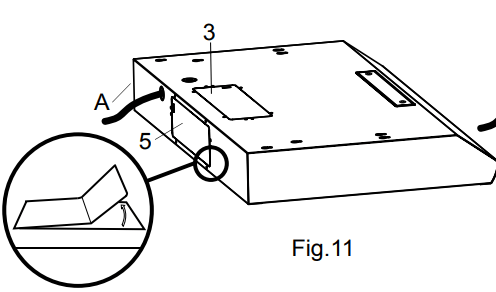
(FOR INTERIOR VENTING)
- If you are venting indoors, unscrew the 2 screws holding cover (6) in place and remove the cover as per Fig. 12. DO NOT REMOVE ANY OTHER VENTING HOLE COVER
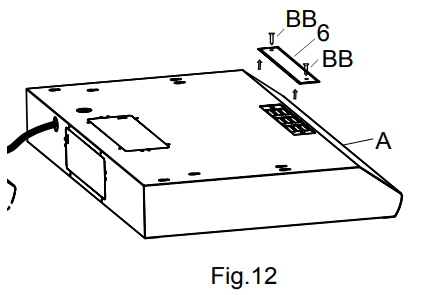
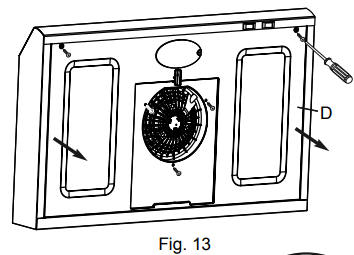

INSTALLING THE RANGE HOOD
- Lift the range hood (A) up under the cabinet to determine its final position. Mark the location of the four keyhole mounting slots (1) on the underside of the cabinet.
- Set the range hood (A) aside on a protective surface.
- Drill four pilot holes in the locations that you marked . - Screw the four long tapping screws (AA) into the pilot holes . Do not tighten the screws all the way
– leave the screw heads about 7 mm (0.28 in) from the cabinet surface .
- Lift the range hood (A) into position, feeding the power cable and the electrical wires through the power access opening . Allow some slack in the cable and wires so that the appliance can be moved if servicing is ever necessary .
- Position the range hood (A) so the large end (2) of the keyhole mounting slots (1) are over the screws (AA). Then push the range hood (A) toward the wall so the screws (AA) are in the neck (3) of the keyhole slots. Tighten the screws (AA). Ensure that the range hood (A) is securely fastened to the cabinet before releasing it .
- If applicable, test the damper blade to ensure it rotates up and down freely .
- If applicable, connect the duct work to the range hood (A). Seal the joints with duct tape to ensure an airtight fit.
- Use the supplied filler strips (optional) to fill any gaps between the range hood and the backsplash. Secure them using double-sided tape and an appropriate adhesive .
- Reinstall the bottom panel and filters as shown in Fig. 17.
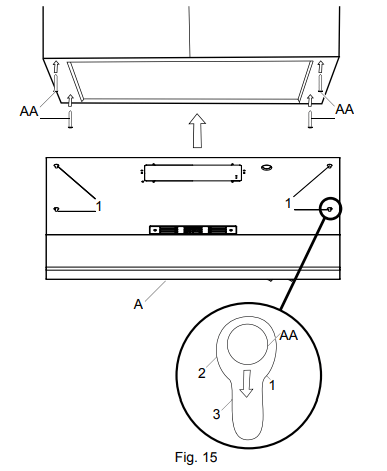
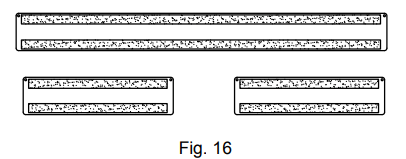
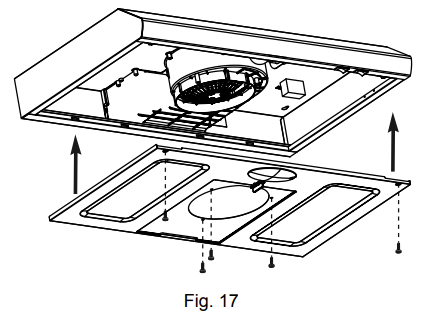
FINAL STEP
- Reconnect the power supply cable and wires to the electrical supply . Turn the power on and ensure that the lights and fan are operating correctly
INSTALLING THE CHARCOAL FILTER (SKIP THIS STEP IF YOU ARE USING EXTERIOR VENTING)
- Turn the filter clip to either side and lift the aluminum filter.
- Place the charcoal filter (B) in place, ensure that it covers the air outlet entirely.
- Turn the filter clip so that the end of the clip holds the filter firmly in place.

Operation
TURNING ON/OFF THE UNIT
- To turn on the fan, press the appropriate speed control switch [Low Speed (3), High Speed (1)] to select the desired level of power . Once a button is pressed, the previous speed mode will be cancelled .
- Press the power switch (2) to turn off the fan.
TURNING ON/OFF THE LIGHTS
- Press the light switch (4) to turn on the lights.
- Press the light switch (5) to turn off the lights.
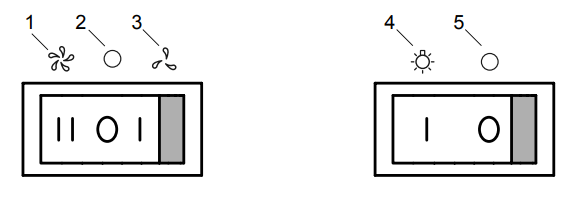
Maintenance
REPLACING FILTERS
When filters need replacing, exchange with similar. Also replace filters that are damaged with punctures, bends, or broken frames .
- Turn off the range hood and disconnect the power .
- Replace with an equivalent filter, then reconnect the power .
REPLACING LIGHT BULBS
When light bulbs burn out, replace them with a 40W E26 base light bulb .
- Turn off the range hood, disconnect it from its power source, and ensure that the lights are cool
- Turn the bulb counter-clockwise and pull it out to remove it .
- Push in the new bulb and turn it clockwise . Do not release the bulb until you are sure the bulb has been securely installed . Then reconnect the power .
- If new bulbs do not operate, ensure that they are inserted correctly .
DANGER: Turn off the power circuit breaker or the power switch on the junction box before performing maintenance . Touching circuitry inside the range hood while it is energized will result in death or serious injury
WARNING:
- Failure to replace worn-out or damaged filters will increase the risk of fire.
- Light bulbs can become hot when turned on . Do not touch bulbs until they are switched off and cooled . Touching hot bulbs could cause serious burns
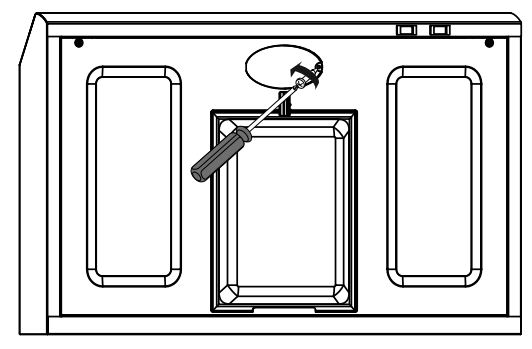

Care and Cleaning
RANGE HOOD
The range hood should be cleaned (regularly internally and externally) to preserve its appearance and performance.
Do:
- Always clean in the direction of the grain (original polish lines).
- Clean the range hood periodically with hot, soapy water and a clean cotton cloth .
- Always rinse well with clean water two or three times after cleaning . Wipe completely dry with a soft non-abrasive cloth.
- After cleaning, you may polish with a nonabrasive stainless steel polish or cleaner . Always rub lightly and with the grain
- Ensure that the venting system is free of debris, if you have one
- Always clean in the direction of the grain (original polish lines).
- Clean the range hood periodically with hot, soapy water and a clean cotton cloth .
- Always rinse well with clean water two or three times after cleaning . Wipe completely dry with a soft non-abrasive cloth.
- After cleaning, you may polish with a nonabrasive stainless steel polish or cleaner . Always rub lightly and with the grain
- Ensure that the venting system is free of debris, if you have one
Do Not:
- Do not use corrosive or abrasive detergents, steel wool, or scouring pads . These will scratch and damage the stainless steel surface .
- Do not use any products containing chloride, fluoride, iodide, or bromide on this product, as they will deteriorate the surface rapidly .
- Do not allow cleaning compounds, salt solutions, disinfectants, or bleaches to remain in contact with the product for extended periods of time .
- Do not allow any deposits to remain for long periods of time on the range hood . Rinse with water immediately and wipe dry with a clean cloth
- Do not let plaster dust or any other construction residue enter the hood . During construction or renovation, cover the hood .
- Combustible products used for cleaning such as acetone, alcohol, ether, or benzol are highly explosive and should never be used close to a range or stove
FILTER
The filter fitted by the factory is intended to filter out residue and grease from cooking. You do not need to replace them on a regular basis, but you should keep them clean
Do:
- Clean the filter once a month using nonabrasive detergents, either by hand or in the dishwasher . When using a dishwasher, set the dishwasher to a low temperature and a short cycle setting. The filter may become discolored in a dishwasher, but this does not affect its performance .
- Allow filters to completely dry before reinstalling them in the range hood
Do Not:
- Do not allow oil to accumulate over more than 80% of the filter surface. Oil accumulations may drip oil onto the range .
- Do not wash the charcoal filter. The charcoal filter should be replaced when it is covered in grease and has reached its maximum absorbency
Troubleshooting
Problem | Solution |
| The range hood does not operate | - Check that the power supply cable and all electrical wiring are properly connected . - Check that the power is turned on at the junction box or circuit breaker . - Check that the wiring between the switch control and the control board are connected properly |
| The range hood vibrates when the fan is operating | - Check that the range hood has been secured properly . Tighten into position, if necessary . - Check that the motor is secured in place . If not, then tighten the motor in place . - Check that the fan is not damaged . If so, replace the fan |
| The fans seem weak | - Check that the duct size used is at least 177 mm (7 in) round. The range hood will not function efficiently with insufficient duct size. - Check that the duct is not clogged with debris and the tight mesh on the wall cap, if applicable, isn’t restricting airflow. - Check that the damper unit is opening properly . - Check that no birds or animals have nested in the duct . |
| The lights work, but the fan is not spinning, is stuck, or is rattling | - The thermal protection system detects if the motor is too hot to operate and shuts the motor down . In this case, the motor will function properly after the thermal protection system cools down (after approximately 10 min). - Check that the fan isn’t jammed or scraping the bottom . - If nothing else works, the motor may be defective or seized . If so, replace the motor |
| The range hood is not venting properly . | - Check that no birds or animals have nested in the duct . - Check that the distance between the cooktop and the bottom of the range hood is between 458 mm (18 in) and 710 mm (28 in). - Check that ductwork follows all requirements . Use round metal duct work with a uniform diameter of 177 mm (7 in). The length of ductwork must not exceed 35 ft (10.7 m). Reduce the length of duct work and the number of elbows if necessary . Ensure that all joints are properly connected, sealed, and taped . - Check that the duct does not open against the wind . - Ensure that the power is on high speed for heavy cooking . - Close all windows nearest to the range hood to eliminate sudden air gusts . - To enhance the performance of the range hood, open slightly a window on the opposite side of the house where the range hood vents outdoors . |
| A light does not work | - Check to see if light bulb is burnt . If so, replace . - Check the light bulb to see if it is loose . If so, tighten . - Remove the problem bulb and insert one you know is working . If the properly functioning light does not come on, the problem may be the light assembly . Have the light assembly serviced or replaced |
Specifications

See other models: CRH300C1S CMH16M1B CMH16G1W CMH16G1W CCM11MC1B
